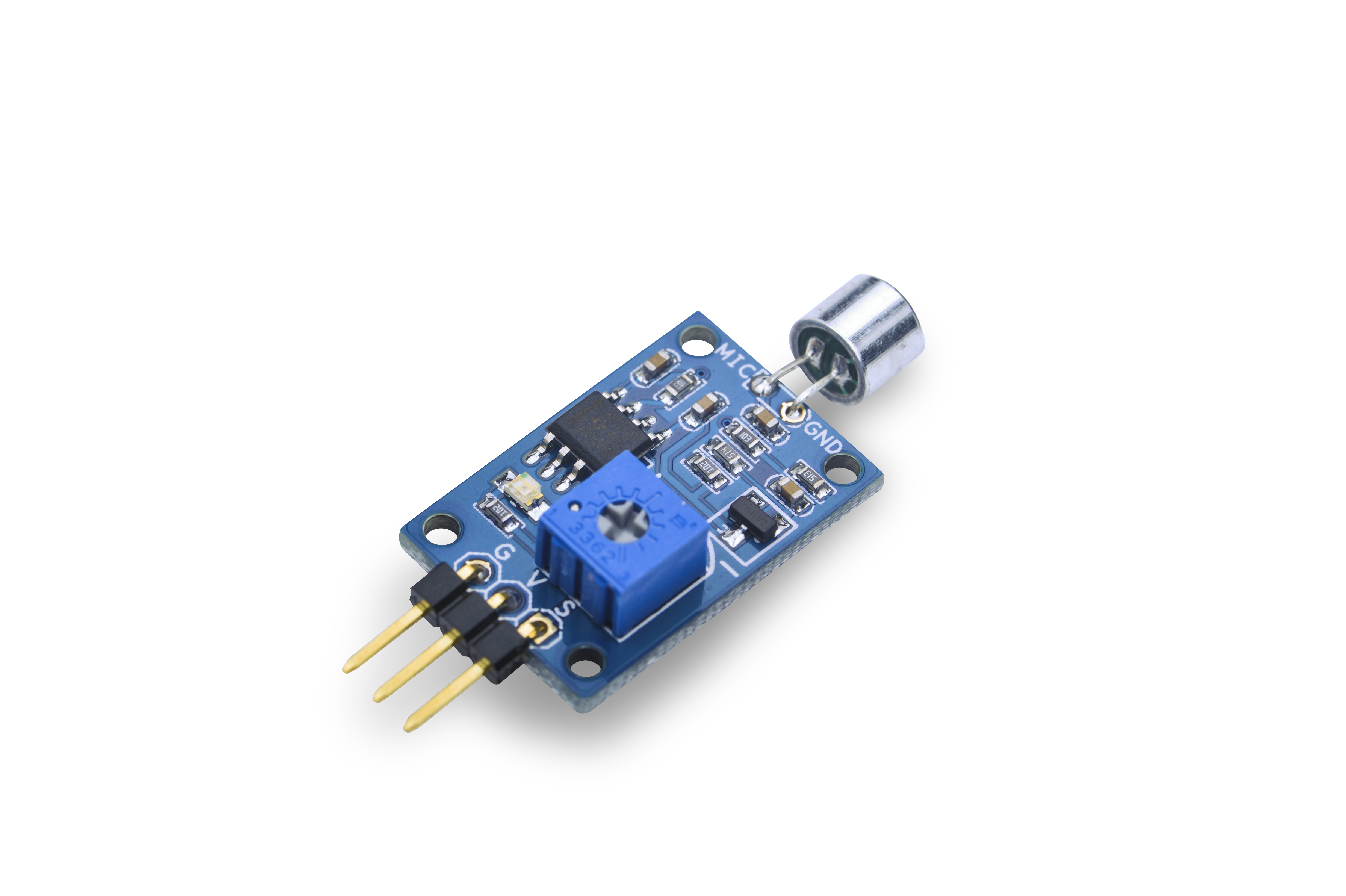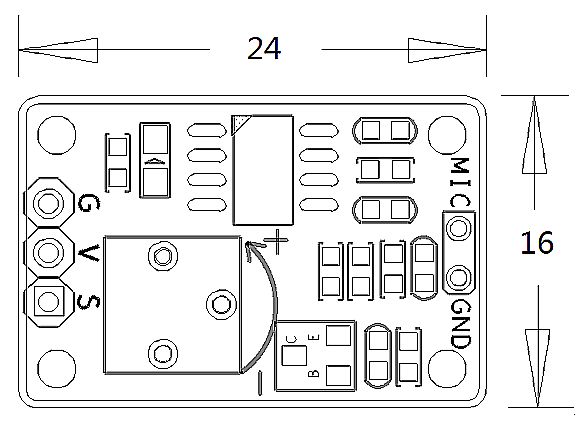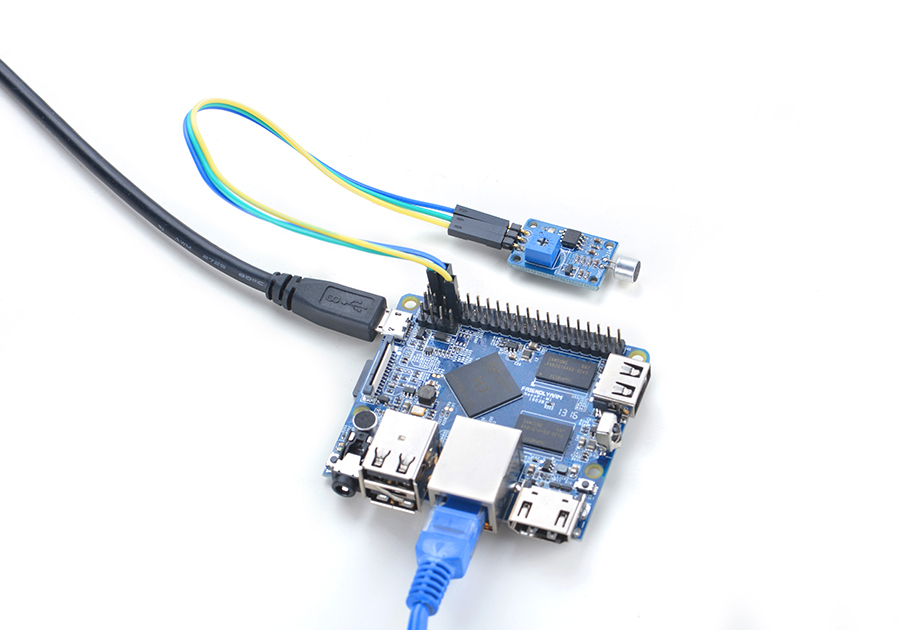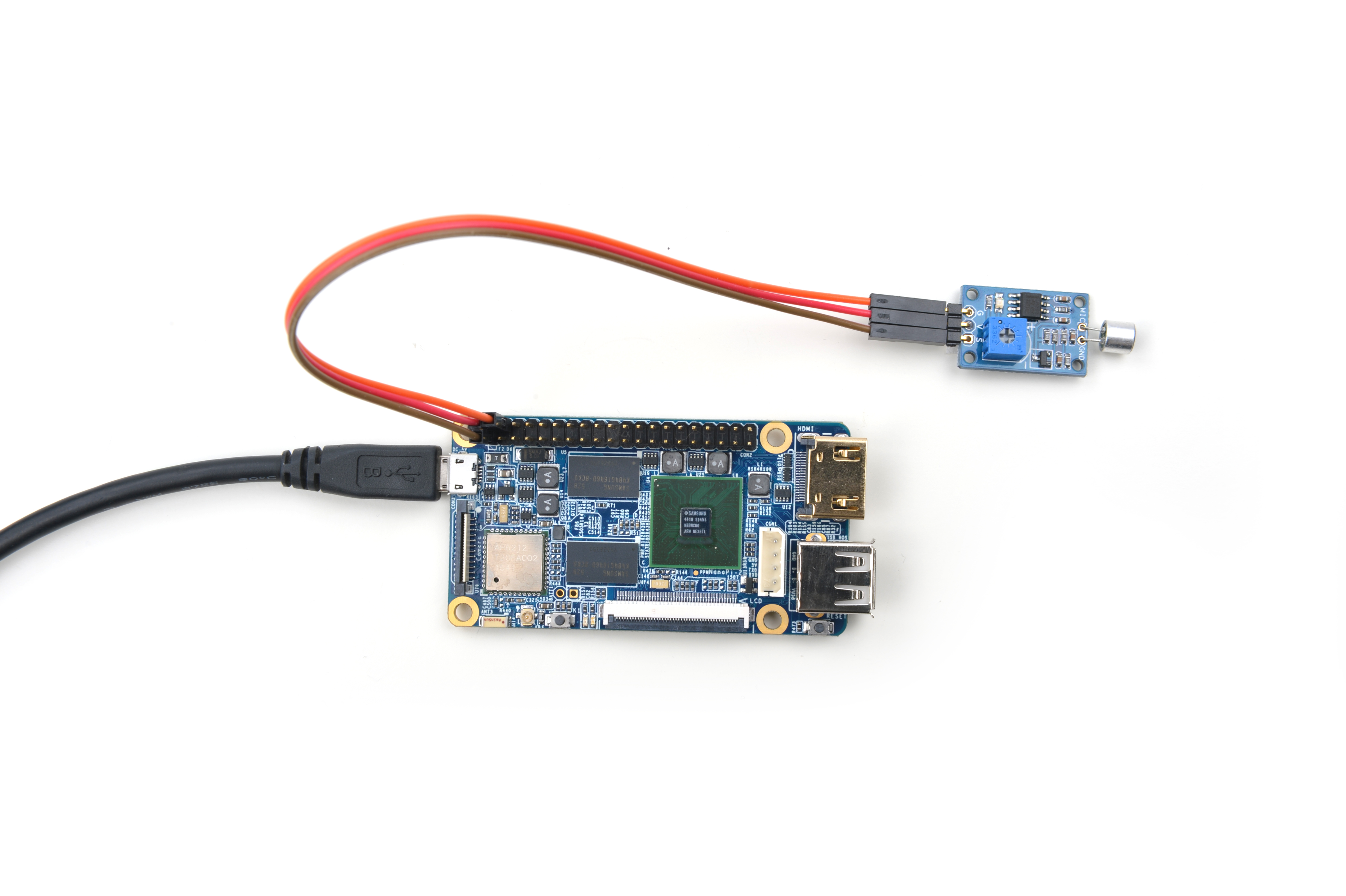Difference between revisions of "Matrix - Sound Sensor/zh"
From FriendlyELEC WiKi
(→特性) |
(→连接NanoPC-T2) |
||
| (38 intermediate revisions by 2 users not shown) | |||
| Line 3: | Line 3: | ||
==介绍== | ==介绍== | ||
[[File:SoundSensor01.png|thumb|Sound Sensor]] | [[File:SoundSensor01.png|thumb|Sound Sensor]] | ||
| − | + | * 模块Matrix-Sound_Sensor用于检测声音。 | |
| + | * 模块上的可调电阻可以调整响应的阀值,顺时针旋转可调电阻增大阀值,即音量较大时才被检测到。 | ||
| + | * 在默认状态下输出高电平,当检测到有声音的时候输出低电平,声音消失后恢复高电平,没有延时。 | ||
==特性== | ==特性== | ||
| Line 11: | Line 13: | ||
[[File:micpcb.png|frameless|400px|声音传感器PCB]] | [[File:micpcb.png|frameless|400px|声音传感器PCB]] | ||
| − | + | * 引脚说明: | |
| − | = | + | {| class="wikitable" |
| − | + | |- | |
| − | + | |名称 || 描述 | |
| − | + | |- | |
| − | + | |S || GPIO | |
| + | |- | ||
| + | |V || 电源5V | ||
| + | |- | ||
| + | |G || 地 | ||
| + | |} | ||
| − | === | + | ==工作原理== |
| − | + | *该传感器内置一个对声音敏感的电容式驻极体话筒。声波使话筒内的驻极体薄膜振动,导致电容的变化,而产生与之对应变化的微小电压。 | |
| − | + | *声音传感器的作用相当于一个话筒(麦克风)。它用来接收声波,显示声音的振动图象。当接收当声音时会输出1,但不能对噪声的强度进行测量。 | |
| − | + | ||
| − | + | ==硬件连接== | |
| − | + | ===连接NanoPi NEO/NanoPi NEO Air=== | |
| − | + | NanoPi M1和NanoPi NEO以及NanoPi NEO Air的前24Pin引脚定义是一模一样的,所以它们操作Matrix配件的步骤是一样的,并且使用同一份代码。<br> | |
| − | + | ||
| − | + | ||
| − | + | ||
| − | int main( | + | 参考下图连接模块:<br> |
| + | [[File:Matrix-Sound_Sensor_nanopi_NEO.jpg|frameless|600px|Matrix-Sound_Sensor_nanopi_NEO]] | ||
| + | |||
| + | 连接说明: | ||
| + | {| class="wikitable" | ||
| + | |- | ||
| + | |Matrix-Sound_Sensor || NanoPi NEO | ||
| + | |- | ||
| + | |S || Pin7 | ||
| + | |- | ||
| + | |V || Pin4 | ||
| + | |- | ||
| + | |G || Pin6 | ||
| + | |} | ||
| + | |||
| + | ===连接NanoPi M1=== | ||
| + | 参考下图连接模块:<br> | ||
| + | [[File:Matrix-Sound_Sensor_nanopi_m1.jpg|frameless|600px|Matrix-Sound_Sensor_nanopi_m1]] | ||
| + | |||
| + | 连接说明: | ||
| + | {| class="wikitable" | ||
| + | |- | ||
| + | |Matrix-Sound_Sensor || NanoPi M1 | ||
| + | |- | ||
| + | |S || Pin7 | ||
| + | |- | ||
| + | |V || Pin4 | ||
| + | |- | ||
| + | |G || Pin6 | ||
| + | |} | ||
| + | |||
| + | ===连接NanoPi 2=== | ||
| + | 参考下图连接模块:<br> | ||
| + | [[File:Matrix-Sound_Sensor_nanopi_2.jpg|frameless|600px|Matrix-Sound_Sensor_nanopi_2]] | ||
| + | |||
| + | 连接说明: | ||
| + | {| class="wikitable" | ||
| + | |- | ||
| + | |Matrix-Sound_Sensor || NanoPi 2 | ||
| + | |- | ||
| + | |S || Pin7 | ||
| + | |- | ||
| + | |V || Pin4 | ||
| + | |- | ||
| + | |G || Pin6 | ||
| + | |} | ||
| + | |||
| + | ===连接NanoPi M2 / NanoPi 2 Fire=== | ||
| + | NanoPi M2和NanoPi 2 Fire的40 Pin引脚定义是一模一样的,所以它们操作Matrix配件的步骤是一样的,这里仅以NanoPi M2为例。<br> | ||
| + | 参考下图连接模块:<br> | ||
| + | [[File:Matrix-Sound_Sensor_nanopi_m2.jpg|frameless|600px|Matrix-Sound_Sensor_nanopi_m2]] | ||
| + | |||
| + | 连接说明: | ||
| + | {| class="wikitable" | ||
| + | |- | ||
| + | |Matrix-Sound_Sensor || NanoPi M2 | ||
| + | |- | ||
| + | |S || Pin7 | ||
| + | |- | ||
| + | |V || Pin4 | ||
| + | |- | ||
| + | |G || Pin6 | ||
| + | |} | ||
| + | |||
| + | ===连接NanoPi M3=== | ||
| + | 参考下图连接模块:<br> | ||
| + | [[File:Matrix-Sound_Sensor_nanopi_m3.jpg|frameless|600px|Matrix-Sound_Sensor_nanopi_m3]] | ||
| + | |||
| + | 连接说明: | ||
| + | {| class="wikitable" | ||
| + | |- | ||
| + | |Matrix-Sound_Sensor || NanoPi M3 | ||
| + | |- | ||
| + | |S || Pin7 | ||
| + | |- | ||
| + | |V || Pin4 | ||
| + | |- | ||
| + | |G || Pin6 | ||
| + | |} | ||
| + | |||
| + | ===连接NanoPC-T2/NanoPC=T3=== | ||
| + | 由于NanoPC-T2跟NanoPC-T3的引脚是一样的,所以连接方式是一样的,这里仅以T2为例,参考下图连接模块:<br> | ||
| + | [[File:Matrix-Sound_Sensor_NanoPC-T2.jpg|frameless|600px|Matrix-Sound_Sensor_NanoPC-T2]] | ||
| + | |||
| + | 连接说明: | ||
| + | {| class="wikitable" | ||
| + | |- | ||
| + | |Matrix-Sound_Sensor || NanoPC-T2 | ||
| + | |- | ||
| + | |S || Pin15 | ||
| + | |- | ||
| + | |V || Pin29 | ||
| + | |- | ||
| + | |G || Pin30 | ||
| + | |} | ||
| + | |||
| + | ==编译运行测试程序== | ||
| + | 启动开发板并运行Debian系统,进入系统后克隆Matrix代码仓库: | ||
| + | <syntaxhighlight lang="bash"> | ||
| + | $ apt-get update && apt-get install git | ||
| + | $ git clone https://github.com/friendlyarm/matrix.git | ||
| + | </syntaxhighlight> | ||
| + | 克隆完成后会得到一个名为matrix的目录。 | ||
| + | |||
| + | 编译并安装Matrix: | ||
| + | <syntaxhighlight lang="bash"> | ||
| + | $ cd matrix | ||
| + | $ make && make install | ||
| + | </syntaxhighlight> | ||
| + | |||
| + | 运行测试程序: | ||
| + | <syntaxhighlight lang="bash"> | ||
| + | $ matrix-gpio_int | ||
| + | </syntaxhighlight> | ||
| + | 注意:此模块并不支持热插拔,启动系统前需要确保硬件连接正确。<br> | ||
| + | 运行效果如下:<br> | ||
| + | <syntaxhighlight lang="bash"> | ||
| + | Waiting event... | ||
| + | Device[0] value is 1 | ||
| + | </syntaxhighlight> | ||
| + | 当周围环境有声音时会检测到事件。 | ||
| + | |||
| + | ==代码说明== | ||
| + | 所有的开发板都共用一套Matrix代码,本模块的测试示例代码为matrix-gpio_int,内容如下: | ||
| + | <syntaxhighlight lang="c"> | ||
| + | int main(int argc, char ** argv) | ||
{ | { | ||
| − | int i; | + | int i, board; |
int retSize = -1; | int retSize = -1; | ||
| − | char value[ARRAY_SIZE( | + | char value[ARRAY_SIZE(dev)]; |
| − | + | ||
| − | if (( | + | if ((board = boardInit()) < 0) { |
| − | printf("Fail to init | + | printf("Fail to init board\n"); |
return -1; | return -1; | ||
} | } | ||
| − | + | ||
| − | if (( retSize = sensorRead(devFD, value, ARRAY_SIZE( | + | if (argc == 2) |
| + | dev[0].pin = atoi(argv[1]); | ||
| + | system("modprobe "DRIVER_MODULE); | ||
| + | signal(SIGINT, intHandler); | ||
| + | if (board == BOARD_NANOPI_T2) | ||
| + | dev[0].pin = GPIO_PIN(15); | ||
| + | printf("Use GPIO_PIN(%d)\n", dev[0].pin); | ||
| + | if ((devFD =sensorInit(dev, ARRAY_SIZE(dev))) == -1) { | ||
| + | printf("Fail to init sensor\n"); | ||
| + | goto err; | ||
| + | } | ||
| + | printf("Waiting event...\n"); | ||
| + | if ((retSize = sensorRead(devFD, value, ARRAY_SIZE(dev))) == -1) { | ||
printf("Fail to read sensors\n"); | printf("Fail to read sensors\n"); | ||
} | } | ||
if (retSize > 0) { | if (retSize > 0) { | ||
i = 0; | i = 0; | ||
| − | for(i=0; i<retSize; i++) | + | for (i=0; i<retSize; i++) { |
| − | + | printf("Device[%d] value is %d\n", i, value[i]); | |
| − | printf(" | + | |
} | } | ||
| − | |||
} | } | ||
sensorDeinit(devFD); | sensorDeinit(devFD); | ||
| + | err: | ||
| + | system("rmmod "DRIVER_MODULE); | ||
return 0; | return 0; | ||
} | } | ||
</syntaxhighlight> | </syntaxhighlight> | ||
| − | + | API说明参考维基:[[Matrix API reference manual/zh|Matrix API reference manual]] <br> | |
| − | + | ||
| − | + | ||
| − | + | ||
| − | + | ||
| − | + | ||
| − | + | ||
| − | + | ||
| − | < | + | |
| − | + | ||
==相关资料== | ==相关资料== | ||
Latest revision as of 08:57, 10 November 2016
Contents
[hide]1 介绍
- 模块Matrix-Sound_Sensor用于检测声音。
- 模块上的可调电阻可以调整响应的阀值,顺时针旋转可调电阻增大阀值,即音量较大时才被检测到。
- 在默认状态下输出高电平,当检测到有声音的时候输出低电平,声音消失后恢复高电平,没有延时。
2 特性
- 阀值可调,即时响应
- 2.54mm排针接口,接线方便,通用性强
- PCB尺寸(mm):16x24
- 引脚说明:
| 名称 | 描述 |
| S | GPIO |
| V | 电源5V |
| G | 地 |
3 工作原理
- 该传感器内置一个对声音敏感的电容式驻极体话筒。声波使话筒内的驻极体薄膜振动,导致电容的变化,而产生与之对应变化的微小电压。
- 声音传感器的作用相当于一个话筒(麦克风)。它用来接收声波,显示声音的振动图象。当接收当声音时会输出1,但不能对噪声的强度进行测量。
4 硬件连接
4.1 连接NanoPi NEO/NanoPi NEO Air
NanoPi M1和NanoPi NEO以及NanoPi NEO Air的前24Pin引脚定义是一模一样的,所以它们操作Matrix配件的步骤是一样的,并且使用同一份代码。
参考下图连接模块:
Matrix-Sound_Sensor_nanopi_NEO
连接说明:
| Matrix-Sound_Sensor | NanoPi NEO |
| S | Pin7 |
| V | Pin4 |
| G | Pin6 |
4.2 连接NanoPi M1
连接说明:
| Matrix-Sound_Sensor | NanoPi M1 |
| S | Pin7 |
| V | Pin4 |
| G | Pin6 |
4.3 连接NanoPi 2
连接说明:
| Matrix-Sound_Sensor | NanoPi 2 |
| S | Pin7 |
| V | Pin4 |
| G | Pin6 |
4.4 连接NanoPi M2 / NanoPi 2 Fire
NanoPi M2和NanoPi 2 Fire的40 Pin引脚定义是一模一样的,所以它们操作Matrix配件的步骤是一样的,这里仅以NanoPi M2为例。
参考下图连接模块:
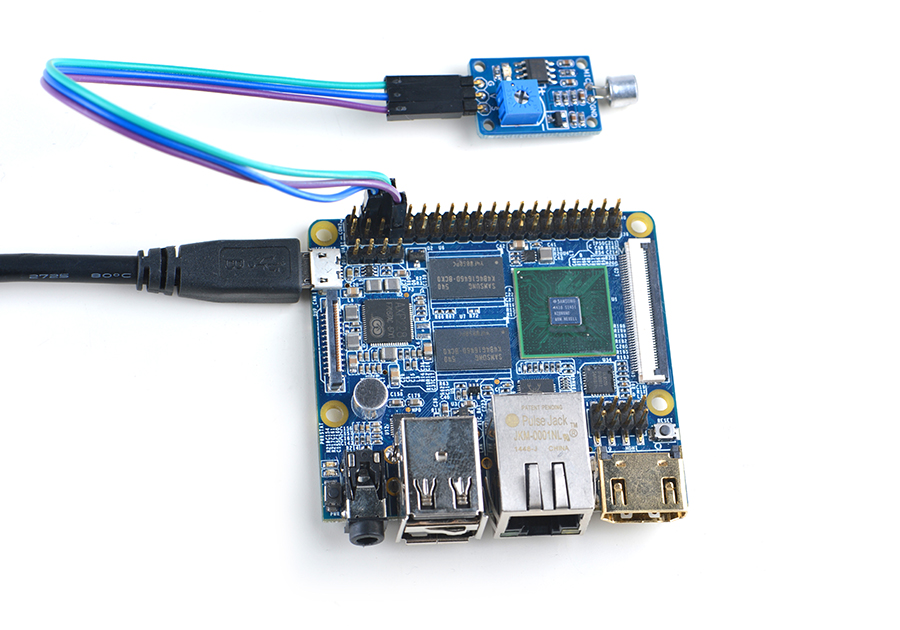
连接说明:
| Matrix-Sound_Sensor | NanoPi M2 |
| S | Pin7 |
| V | Pin4 |
| G | Pin6 |
4.5 连接NanoPi M3
参考下图连接模块:
Matrix-Sound_Sensor_nanopi_m3
连接说明:
| Matrix-Sound_Sensor | NanoPi M3 |
| S | Pin7 |
| V | Pin4 |
| G | Pin6 |
4.6 连接NanoPC-T2/NanoPC=T3
由于NanoPC-T2跟NanoPC-T3的引脚是一样的,所以连接方式是一样的,这里仅以T2为例,参考下图连接模块:
Matrix-Sound_Sensor_NanoPC-T2
连接说明:
| Matrix-Sound_Sensor | NanoPC-T2 |
| S | Pin15 |
| V | Pin29 |
| G | Pin30 |
5 编译运行测试程序
启动开发板并运行Debian系统,进入系统后克隆Matrix代码仓库:
$ apt-get update && apt-get install git $ git clone https://github.com/friendlyarm/matrix.git
克隆完成后会得到一个名为matrix的目录。
编译并安装Matrix:
$ cd matrix $ make && make install
运行测试程序:
$ matrix-gpio_int注意:此模块并不支持热插拔,启动系统前需要确保硬件连接正确。
运行效果如下:
Waiting event... Device[0] value is 1
当周围环境有声音时会检测到事件。
6 代码说明
所有的开发板都共用一套Matrix代码,本模块的测试示例代码为matrix-gpio_int,内容如下:
int main(int argc, char ** argv) { int i, board; int retSize = -1; char value[ARRAY_SIZE(dev)]; if ((board = boardInit()) < 0) { printf("Fail to init board\n"); return -1; } if (argc == 2) dev[0].pin = atoi(argv[1]); system("modprobe "DRIVER_MODULE); signal(SIGINT, intHandler); if (board == BOARD_NANOPI_T2) dev[0].pin = GPIO_PIN(15); printf("Use GPIO_PIN(%d)\n", dev[0].pin); if ((devFD =sensorInit(dev, ARRAY_SIZE(dev))) == -1) { printf("Fail to init sensor\n"); goto err; } printf("Waiting event...\n"); if ((retSize = sensorRead(devFD, value, ARRAY_SIZE(dev))) == -1) { printf("Fail to read sensors\n"); } if (retSize > 0) { i = 0; for (i=0; i<retSize; i++) { printf("Device[%d] value is %d\n", i, value[i]); } } sensorDeinit(devFD); err: system("rmmod "DRIVER_MODULE); return 0; }
API说明参考维基:Matrix API reference manual
